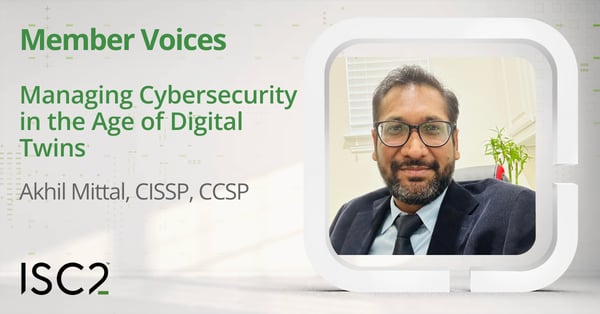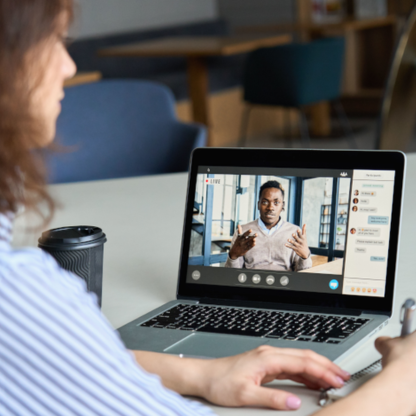Digital twins are a popular and practical way of monitoring, testing and modelling changes and scenario, but these systems present a number of cybersecurity and operational considerations in their use. Akhil Mittal, CISSP, CCSP, shares his experience of using and securing digital twins in organizations.
 A digital twin is a virtual representation of a system designed to
accurately reflect its physical state. It may be updated with real-time data
and may use simulation, machine learning or reasoning to help its operators
– or itself – to make decisions.
A digital twin is a virtual representation of a system designed to
accurately reflect its physical state. It may be updated with real-time data
and may use simulation, machine learning or reasoning to help its operators
– or itself – to make decisions.
Imagine, for example, a future where an airport is fully managed by its digital twin. It tracks everything from flight schedules to baggage handling. It predicts delays and potential problems with incredible accuracy. Or a factory in which managers use a digital twin to test different production scenarios. They can spot inefficiencies and make adjustments to boost output and cut downtime. In healthcare, a digital twin of a patient's health combines data from multiple sources, giving doctors a complete view that leads to better, personalized treatments. In smart cities, digital twins track everything from traffic flow to energy usage, making city management more efficient and improving life for residents.
This isn't just a futuristic idea: digital twins are already changing the game across various industries by offering new insights and optimizing operations. With the rise of health-tracking wearables, smartphones and other devices, data collection and computer modeling have seamlessly integrated into our everyday routines.
Digital Twins Come with Cybersecurity Risks
Digital twins bring impressive benefits, like better decision-making and reduced downtime. But they also come with new cybersecurity risks. The more connected a system is, the more chances there are for something to go wrong. A single weak spot in a digital twin could make the whole network vulnerable.
A few years ago, I worked on creating a digital twin for a global company’s IT system. Our goal was to predict and prevent problems before they occurred. The project went well, but handling the huge amount of data exchanged between the physical and digital worlds was challenging. This experience showed me just how important strong cybersecurity is for a digital twin project.
Data integrity is a major concern. The accuracy of a digital twin depends on the quality of the data it processes. For instance, if a digital twin in healthcare is hacked and provides faulty health data, it could lead to incorrect treatments or missed diagnoses. Ensuring data integrity through rigorous validation and secure transmission is vital.
Access control is crucial. Managing who can access and modify a digital twin is essential. Weak access controls could enable unauthorized changes. For example, if a digital twin controls a power grid and isn’t properly protected, unauthorized access could disrupt operations or create safety hazards. Implementing strong authentication methods, like multi-factor authentication (MFA) and role-based access controls, is necessary.
Integration vulnerabilities also pose risks. Digital twins often interconnect with other systems, including IoT devices and cloud services, which can create security weaknesses. Each connection point can be a potential entry for attackers. For example: if an IoT device connected to a digital twin is compromised, it could serve as a gateway for cybercriminals. Securing such connections requires robust network security and continuous monitoring.
Data protection is also critical. The constant flow of data between physical assets and digital twins needs strong protection. In smart cities, real-time traffic data must be encrypted to prevent unauthorized access. Using advanced encryption methods and real-time monitoring systems is essential for safeguarding this data.
Strategies for Securing Digital Twins
To secure digital twins effectively, it’s important to consider potential threats – this is where threat modeling comes in. By identifying and analyzing possible attack points, such as application interfaces and data exchange points, we can design digital twins that are more resilient from the start. For example: threat modeling for a smart city digital twin might reveal vulnerabilities related to IoT integration, prompting improvements like enhanced encryption and secure communication protocols.
After a digital twin is up and running, penetration testing is crucial for maintaining its security. Pen testing simulates real-world attacks to find vulnerabilities before malicious actors do. In one of our projects, a pen test uncovered weak authentication methods within the digital twin of a critical infrastructure. This discovery allowed us to strengthen the system’s defenses, preventing a major security breach.
Additionally, a multi-layered security approach is crucial. Encrypting data - both at rest and in transit - helps prevent unauthorized access. Regular security audits can identify and fix potential weaknesses. For example: an audit might uncover flaws in a digital twin system’s integration process, leading to timely corrective actions.
Implementing advanced access controls, such as multi-factor authentication and role-based access controls, can also significantly reduce the risk of unauthorized access. Multi-factor authentication adds an extra security layer, while role-based access ensures only authorized users interact with specific parts of the system. AI-driven security solutions can further enhance threat detection by analyzing large data volumes to spot anomalies and potential breaches.
Emerging Technologies Enhancing Digital Twins
As digital twins evolve, emerging technologies are enhancing their capabilities. Edge computing, for example, processes data closer to its source, reducing latency and improving responsiveness. Such real-time analysis and decision-making can boost operational efficiency, particularly in time-sensitive environments such as financial services.
Artificial Intelligence (AI) is increasingly integrated with digital twins to enhance predictive capabilities and to automate decision-making. AI algorithms can analyze large amounts of data from digital twins, improving simulations and predictions, and making systems more dynamic and responsive.
5G technology also promises to enhance digital twins by providing faster data transmission and reducing latency. This improvement is especially useful for real-time applications, enabling smoother interactions between physical assets and their digital counterparts.
Decentralized Identifiers (DIDs) are emerging to securely manage digital identities. They decentralize identity management, adding an extra layer of protection and reducing the risk of identity theft, ensuring digital twins are secure from unauthorized access and manipulation.
Blockchain technology is another interesting area. It’s being explored for securing digital twins through decentralized ledgers that ensure data integrity and immutability. Blockchain provides a transparent record of all transactions and modifications, potentially helping to maintain data integrity and prevent unauthorized changes.
Regulatory and Ethical Considerations
As digital twins become more integrated into critical systems, addressing ethical and governance issues is crucial. Organizations need to consider data privacy, consent and the ethical use of digital models. Developing strong governance frameworks and ethical guidelines is essential for ensuring responsible use.
Compliance with data protection regulations like GDPR and HIPAA is also important. Implementing practices such as data anonymization and secure data handling helps meet regulatory requirements and protect sensitive information, building trust with stakeholders.
Looking Ahead
Digital twins are transforming industries and offering great potential for optimization and efficiency. As digital twins evolve, cybersecurity strategies must keep pace. My personal experience with digital twins has shown that, while this technology holds great promise, it’s only as secure as the measures we put in place. The possibilities are exciting, but they also remind us of the need to stay ahead of emerging threats.
Akhil Mittal, CISSP, CCSP, is a security leader at Synopsys with over 19 years of experience in cybersecurity. His expertise spans sectors including finance, healthcare and technology. He has been responsible for leading security assessments, developing strategic security programs and managing client engagements. Akhil’s work encompasses application security, cloud security, AI and DevSecOps.
- Find out more about the CSSLP certification
- ISC2 offers a number of Software Security Skill-Builders covering design and implementation to testing and deployment
- The CrowdStrike software update issue highlighted the importance of robust testing before making changes or deploying
- ISC2 Security Administration and Operations Certificates support cybersecurity professionals with the broad knowledge and skills to install, administer and troubleshoot their security solutions


